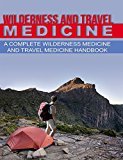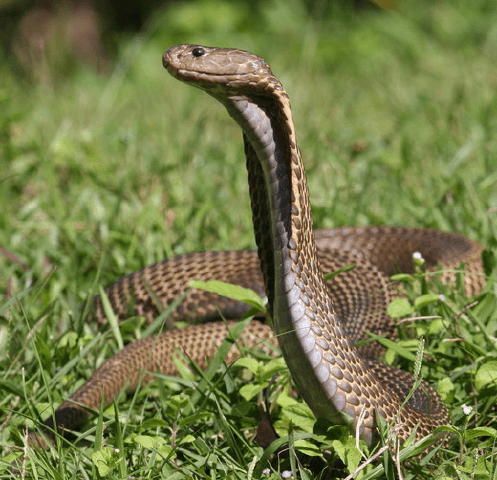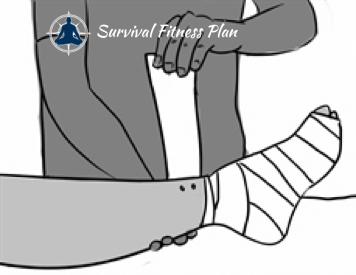Poisonous Snake Bite First Aid Procedures
In this article, you will learn poisonous snake bite first aid procedures. It covers snake bite symptoms and snake bite treatment. This is life-saving information if you live in or visit a country with poisonous snakes.
It also talks about dog snake bite symptoms and treatment, and snake bite on cats. Finally, it gives specific information on some of the most poisonous snakes in the world.
Contents
Prevention of Snake Bites
Snake Bite Protection
Poisonous Snake Bite Symptoms
Snake Bite Treatment
Pressure Immobilization Technique
Non-Poisonous Snake Bites
Snake Bite on Dogs and Cats
Snake Bite Dog Symptoms
Cat and Dog Snake Bite Treatment
Specific Snake Bite Information
Black Mamba
Blue Krait
Copperhead
Coral Snake
Death Adder
Eastern Brown Snake
Philippines Cobra
Rattlesnake
Sea Snake (Cottonmouth)
Taipan
Tiger Snake
Viper Snake Bite First Aid
Conclusion
Could You Save a Loved One When There are No Doctors Around?Get Your Copy of Wilderness and Travel Medicine Today

Wilderness and Travel Medicine: A Complete Wilderness Medicine and Travel Medicine Handbook (Escape, Evasion, and Survival 4)

Price Disclaimer
Poisonous Snake Bite First Aid Procedures
Prevention of Snake Bites
Prevention is always the best cure, and most poisonous snake bites are easy to avoid.
As with any animal, stay away from them. Most will run away before you know they are there anyway. If you do come across one, stand still and back away. Give it plenty of room to escape. Do not tease or try to move it. That is asking for trouble.
Although each snake likes slightly different conditions, most like to hide. Watch out in tall grass, piles of wood or rocks, piles of leaves, etc.
Snakes are cold-blooded so need to warm in the sun. Be extra careful when hiking on a sunny but cool day. This is when snakes are most likely to be sunbathing in the open.
Snake Bite Protection
If working in snake territory, wear protective clothing. Long pants, tall boots, and leather gloves are good.
You can even get special snake bite proof pants and snake bite proof boots. Get your snake bite proof clothing here.
Poisonous Snake Bite Symptoms
Different snakes can present different symptoms. In general, you will get some or all the following:
2 puncture marks
Blurred vision
Breathing difficulty, sometimes extreme
Local swelling and redness
Local pain, often severe
Nausea and vomiting
Numbness or tingling
Salivation
Sweating
*Local refers to being near/around the bite site.
Snake Bite Treatment
As with all life-threatening first aid situations, follow DRABC. Read a detailed article about DRABC here.
Besides DRABC, specific first aid treatment for snake bites is as follows:
Record the time of bite
*Identify the snake if possible
Keep the victim calm and and as still as possible
Remove constricting clothing and jewelry
Administer antivenin if available
Get to a hospital ASAP
*Only do this if it is safe. Don’t try to hunt it down. Take a picture from a safe distance if possible.
DO NOT:
Apply a cold compress
Apply a tourniquet
Cut the snake bite
Give medication (unless directed by a medical professional)
Pump or suck the venom out
Raise the bite
If you live or work close to poisonous snakes it is wise to have a snake bite first aid kit. Ensure you have snake bite antivenin for the snakes you are most likely to come in contact with.
Pressure Immobilization Technique
The pressure immobilization technique is not only for treating snake bites. Use can use it for most venomous bites and stings. The idea is to slow the venom’s movement into the circulatory system. This buys time until the arrival of advanced medical care.
When applying the pressure immobilization technique, keep the patient as still as possible. Especially the site of the venomous snake bite. Do not elevate the wound.
In general, only apply the pressure immobilization technique for:
Australian snakes, all species
Blue-ringed octopus
Conus
Funnel-web spiders
If possible, use an elastic roller bandage
Bandage upwards from the lower part of the bitten or stung limb, and continue up as high as possible. Each wrap should overlap the last.
Ensure the bandage does not impair perfusion (blood flow)
Mark the location of the bite on the bandage
Immobilize the limb
Check perfusion often as continued swelling may impair it
Note: Do not bandage bites/stings to the head or torso. Keep patient still and seek medical care ASAP.
Non-Poisonous Snake Bites
This article focuses on poisonous snake bites, but I want to touch on non-poisonous snake bites too.
The physical symptoms will be the same:
2 puncture wounds
Local swelling and redness
Local pain
You will not normally get the other symptoms (vomiting, blurred vision, etc).
Treat a non-venomous snake wound as a puncture wound. If you have any doubt, treat the snake bite as venomous!
The basic steps for treating a non-venomous snake wound are:
Apply direct pressure to stop the bleeding
Clean the wound with mild soap and clean water
Apply a topical antiseptic such as Povidone Iodine
Cover the wound with a sterile bandage
See a doctor for follow-up asap. You may need antibiotics.
Snake Bite on Dogs and Cats
Dogs and cats may try to play with or kill snakes. This often results in them getting bit.
Snake Bite Dog Symptoms
Symptoms of a snake bite in dogs are like those on humans, but the onset will be faster since they are smaller. In general, the smaller the dog, the less chance of survival it will have. Following this logic, a cat snake bite is even more lethal.
Look for the following symptoms:
Blood in urine
Collapse
Dilated pupils
Loss of bladder and bowel control
Muscle spasm
Paralysis
Sudden weakness
Vomiting
Cat and Dog Snake Bite Treatment
The treatment for snake bites on animals is the same as for humans. The only difference is to go to a vet instead of a hospital.
Carry your pet wherever it needs to go and get antivenin as quickly as possible.
If possible, you can use the pressure immobilization technique, e.g., for a snake bite on dog leg.
Whether it is a rattlesnake bite on a dog or some other species, the main thing is to keep the animal still. Get to a vet and give it some snake bite antivenom ASAP.
Specific Snake Bite Information
There are many types of snakes around the world. Here we will go over some of the most poisonous ones.
The general treatment is the same for all poisonous snakes. The difference is the type of antivenin. This is why it is important to identify the type of snake bite. Study the pictures.
Note: If someone gets bitten and did not identify the type of snake, do not bother trying to find out. Get to a hospital. They have tests to discover the type of venom.
Black Mamba Bite First Aid
This fast striking snake is in many parts of Africa. Unlike other Mamba species, the Black Mamba is not primarily a tree dweller. Except in the jungle, it prefers rocky crevices, scrub, abandoned burrows, etc.
It is not as aggressive as most people are lead to believe, but I would definitely not mess with it.
Black Mamba bite symptoms include:
Abdominal pain
Confusion
Convulsions
Distorted vision
Fever
Lack of muscle control
Local pain
Nausea and vomiting
Pallor
Paralysis
Respiratory failure
Salivation and foaming of the mouth
Shock
Tingling in extremities
Tingling in mouth

Danleo~commonswiki assumed (based on copyright claims). [GFDL, CC-BY-SA-3.0 or CC BY 2.5 ], via Wikimedia Commons
Blue Krait Bite First Aid
This nocturnal snake is from South East Asia. They are timid most of the time but are highly venomous. They like to hang around water and can grow up to 1m long.
Blue Krait bite symptoms include:
Cramps
Muscle paralysis
Paralysis
Spasms
Tremors

By Bramadi Arya [CC BY-SA 4.0 ], from Wikimedia Commons
Copperhead Bite First Aid
Copperheads are not aggressive, but if you step on one it will react. They are common in the Eastern states of North America. You will find them among rocks, in the woods, or near water sources.
There are also Copperheads in Australia, but they are a different species.
Copperhead bite symptoms include:
Change in skin color
Low blood pressure
Pain
Shock
Weakness

Via Wikicommons, Public Domain.
Coral Snake Bite First Aid
Coral snakes are common in the south of the US. They like to hide in leaf piles, so don’t step or kick one while you are walking!
The symptoms of Coral Snake bites are often delayed by hours.
Coral Snake bite symptoms include:
Change in skin color
Convulsions
Difficulty swallowing
Drooping eyelids
Headache
Pain
Paralysis
Shock
Stomach pain

By Norman.benton [CC BY-SA 3.0 or GFDL], from Wikimedia Commons
Death Adder Bite First Aid
The Death Adder is in Australia and New Guinea. It likes to hide among loose leaf litter and debris and is quite hard to see, especially if not keeping an eye out for one.
Deathadder bite symptoms include:
Drooping eyelids
Muscle weakness
Nausea
Paralysis
Respiratory failure
Speech impairment

CSIRO [CC BY 3.0 ], via Wikimedia Commons
Eastern Brown Snake Bite First Aid
This venomous snake makes its home in the major population centers of Australia. It is fast and may chase you. Luckily, less than half their bites contain venom, and they only react to movement. If you encounter one, stand very still.
Eastern Brown Snake bite symptoms include:
Cardiac arrest
Collapse
Convulsions
Diarrhea
Dizziness
Paralysis
Renal failure

By Poyt448 Peter Woodard [Public domain], from Wikimedia Commons
Philippines Cobra Bite First Aid
This snake has the most poisonous venom of all the cobra’s, and it can spit up to 3 meters. It lives almost anywhere, especially near water.
Philippines Cobra bite symptoms include:
Abdominal pain
Cardiac failure
Convulsions
Diarrhea
Dizziness
Headache
Nausea
Respiratory failure
Vomiting

By Mario Lutz [CC BY-SA 3.0 ], via Wikimedia Commons
Rattlesnake Bite First Aid
Rattlesnakes are one of the most common poisonous snakes in North America. They are also the largest of the poisonous snakes. They like to sunbathe so watch for them on top of rocks, logs, and in open areas.
If you hear the rattle of a rattlesnake, back away. It is your warning!
Rattlesnake bite symptoms include:
Drooping eyelids
Muscle fatigue
Low blood pressure
Severe pain
Thirst
Tiredness

Sea Snake Bite First Aid
Can a snake bite in water? Yes, it can. And all sea/water snakes are very poisonous. In fact, some think the most venomous snake in the world is the Belcher’s Sea Snake from SE Asia and Northern Australia.
The water moccasin is a common water-snake in the southeastern states of the US. They are commonly called a Cottonmouth snake.
Cottonmouth bite symptoms include:
Change in skin color
Low blood pressure
Pain
Shock
Weakness

By Patrick Feller via www.Flickr.com.
Taipan Bite First Aid
There are 3 sub-species of Taipan, all found in Australia. The Coastal Taipan is like the Australian version of the Black Mamba. It has similar aggressive behavior and toxicity.
The Inland Taipan is more venomous but not as aggressive as its coastal relative. This competes with the Belcher’s Sea Snake as most venomous snake in the world.
The 3rd is the Central Ranges Taipan which was only discovered in 2007.
Inland Taipan bite symptoms include:
Abdominal pain
Collapse
Headache
Nausea
Paralysis
Vomiting

Inland Taipan. By Kapa65 via Pixabay.com.
Tiger Snake Bite First Aid
Tiger Snakes are common near water in Australia. They will often run from loud noises but will attack if cornered.
Tiger Snake bite symptoms include:
Foot pain
Neck pain
Tingling
Numbness
Sweating
Reparatory failure
Paralysis

By Catching The Eye via Flickr.com.
Viper Snake Bite First Aid
Vipers are all over the world, but the most poisonous ones are in Asia. They are most active at night and after rain. They anger easily which make them especially dangerous.
Viper bite symptoms include:
Bleeding from the gums
Delayed cardiac failure
Delayed respiratory failure
Facial swelling
Local blistering
Local pain
Local swelling
Low blood pressure
Necrosis
Vomiting

Green Pit Viper. Via Maxpixel.com.
This is the Only First Aid Book You Will Ever NeedGet Your Copy of Wilderness and Travel Medicine Today

Wilderness and Travel Medicine: A Complete Wilderness Medicine and Travel Medicine Handbook (Escape, Evasion, and Survival 4)

Price Disclaimer
Conclusion
There are many venomous snakes in the world and most people will come across one every now and again. If you do, remember to stay still and back away slowly. Give it plenty of room to escape and it will have no reason to attack you.
General first aid for snake bites is not complicated. Keep the victim still and get them some snake bite antivenin ASAP. For Australian snake bites, use the pressure immobilization technique.
Did you find this article about treatment for a snake bite useful? If so, please share it with your friends.
The post Poisonous Snake Bite First Aid Procedures appeared first on Survival Fitness Plan.






